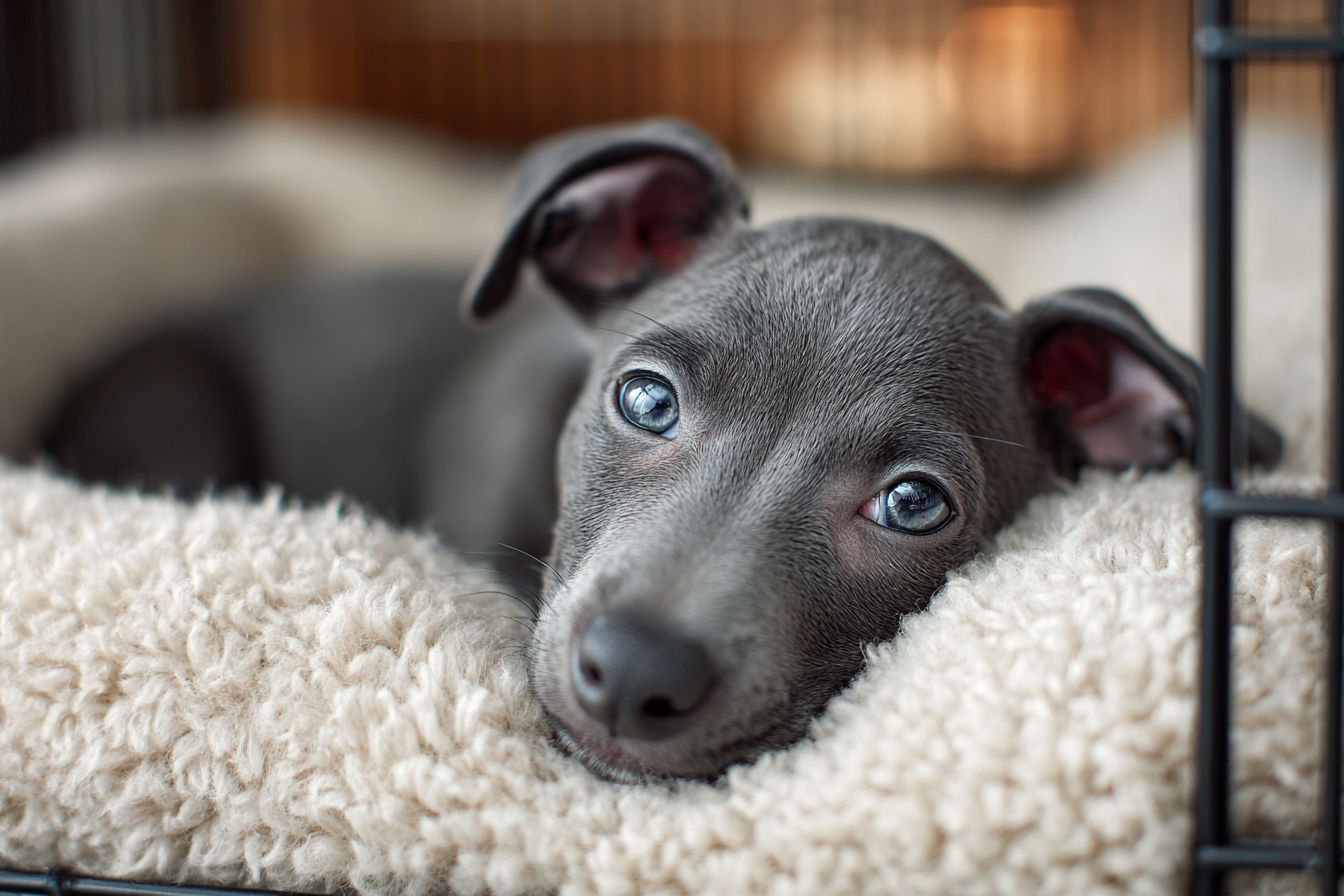Crate training your Italian Greyhound is a fantastic strategy for ensuring your pet’s safety and comfort while also making your life easier as a dog owner. These graceful little dogs are known for their slender build and sensitive nature, which makes a cozy, secure space like a crate an excellent retreat for them. If you’re new to crate training or looking to improve your approach, this step-by-step guide will help you introduce your Italian Greyhound to crate life in a gentle, effective way.
Benefits of Crate Training for Italian Greyhounds
Crate training offers numerous advantages, especially for Italian Greyhounds, who can be prone to anxiety and require a lot of attention. Here are some key benefits:
- Safety: A crate keeps your Italian Greyhound safe when you’re not able to supervise them, preventing destructive behaviors or injury.
- Comfort: Italian Greyhounds love cozy, den-like spaces. A crate can become their personal sanctuary where they feel secure and relaxed.
- House Training: Using a crate helps in potty training by encouraging your dog to hold their bladder because they dislike soiling their sleeping space.
- Travel Ease: Crate-trained dogs tend to cope better with travel stress, whether it’s a visit to the vet or a longer trip, because the crate feels like home.
- Behavioral Benefits: It reduces anxiety and excessive barking when used correctly, giving your Italian Greyhound a peaceful environment.
Choosing the Right Crate Size and Type
Selecting the perfect crate is essential for the success of your training. Italian Greyhounds are slender and relatively small, typically weighing between 7 to 14 pounds, so their crate should be just the right size—roomy enough to move around but cozy enough to feel secure.
When choosing a crate, consider these options:
- Wire Crates: These offer excellent ventilation and visibility. They often come with divider panels allowing the crate size to adjust as your dog grows.
- Plastic or Airline Crates: Providing a more enclosed space, these crates are great for travel and provide a snug environment, often preferred by more anxious dogs.
- Soft-sided Crates: Lightweight and portable, these are suited for calm dogs and short-term use but may not be durable enough for strong chewers.
Measure your Italian Greyhound’s length and height accurately to pick the appropriate crate size. A crate that is around 24 to 30 inches in length generally works well. Remember, the crate should be large enough for your dog to stand up, turn around, and lie down comfortably.
Gradual Introduction Steps
Introducing your Italian Greyhound to the crate gradually helps them adjust without fear or anxiety. Follow these gentle steps:
- Place the crate in a familiar area: Put it somewhere your dog already likes to hang out, such as the living room.
- Keep the door open: Allow your dog to explore freely, encouraging curiosity rather than fear.
- Make it inviting: Add a soft blanket or bed and some favorite toys inside.
- Use treats to encourage entry: Toss tasty treats inside to lure your dog in and reward them for stepping inside.
- Start closing the door briefly: Once your dog feels comfortable entering and exiting, close the door for a few seconds while sitting nearby, gradually increasing the time.
- Extend crate time gradually: Slowly lengthen periods your dog stays inside, always rewarding calm behavior.
Positive Associations With the Crate
Building a positive connection with the crate helps your Italian Greyhound view it as a safe and enjoyable space rather than a punishment. Here are some tips for creating positive associations:
- Feed meals inside the crate: This encourages your dog to associate mealtime with their cozy space.
- Praise and treats: Offer verbal praise and tasty rewards when your dog voluntarily enters or stays calm inside the crate.
- Use interactive toys: Leave chew toys or puzzle feeders inside to keep your pup entertained and happy.
- Calm departures and arrivals: Avoid making a big fuss when putting your dog in or taking them out of the crate to reduce separation anxiety.
Handling Common Challenges
While many Italian Greyhounds adapt quickly to crate training, some common challenges might arise. Here’s how to tackle them:
Whining or Barking
Your dog may initially whine to express discomfort or to get your attention. Avoid opening the crate immediately upon noise to prevent reinforcing the behavior. Instead, wait for a pause before letting your dog out and reward quiet behavior.
Refusal to Enter
If your Italian Greyhound is hesitant to enter, try dropping treats or toys just inside several times. You can also feed all meals inside the crate or use a leash to gently guide them in without forcing.
Destructive Behavior
Chewing or scratching at the crate can happen out of boredom or stress. Make sure to provide ample exercise, mental stimulation, and comfort items inside the crate. Using sturdy crates designed for chewers can also help.
Separation Anxiety
Italian Greyhounds are social dogs and might stress when left alone. Gradually increase alone time while in the crate, pair it with calming music or pheromone sprays, and never use the crate as punishment.
Using the Crate for Travel and Safety
The crate is not only a training tool but also a safe space for travel and emergencies. Italian Greyhounds can feel vulnerable in unfamiliar settings, so bringing their familiar crate offers reassurance.
For car travel, secure the crate with a seatbelt or place it in a stable area in the vehicle to avoid movement. Make sure the crate size is appropriate and your dog is comfortable inside before hitting the road. During vet visits or trips to new places, having the crate ready means your Italian Greyhound has a known refuge, reducing stress and helping them stay calm.
Creating a Safe Haven for Your Italian Greyhound
Ultimately, crate training is about providing your Italian Greyhound with a safe, calming space where they feel protected and loved. By selecting the right crate, introducing it gradually, reinforcing positive associations, and addressing challenges with patience and care, your dog will come to view their crate as a comforting retreat.
Remember, every Italian Greyhound is unique. Pay attention to your dog’s signals and progress at a pace that suits their personality. With a little time and consistency, crate training can become a rewarding experience for both you and your furry companion, enriching your bond and supporting their well-being.







